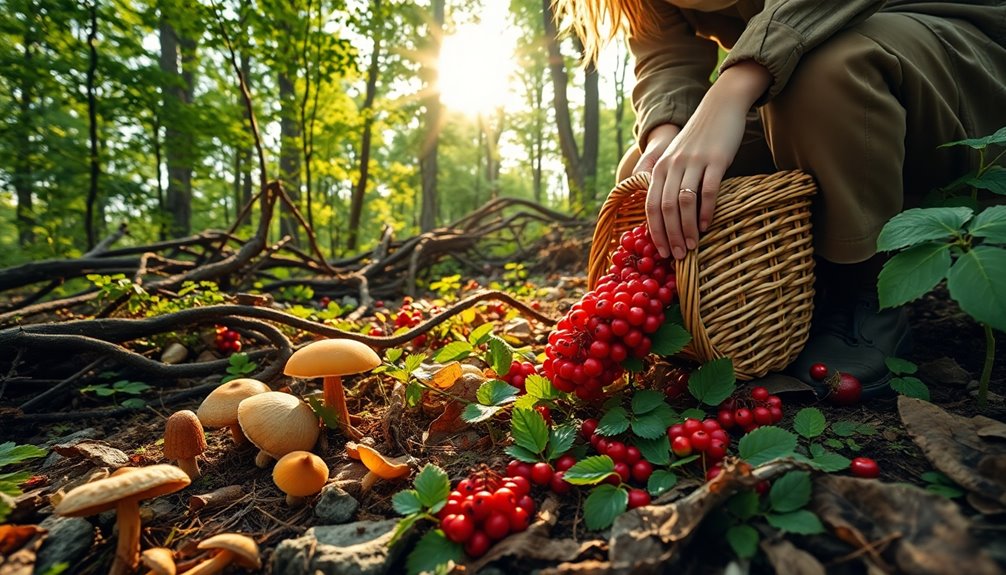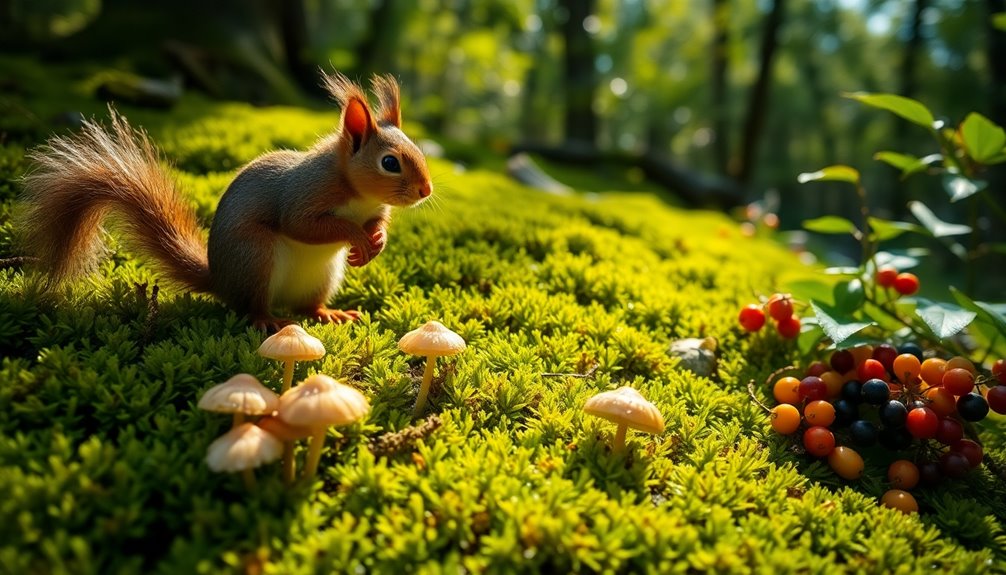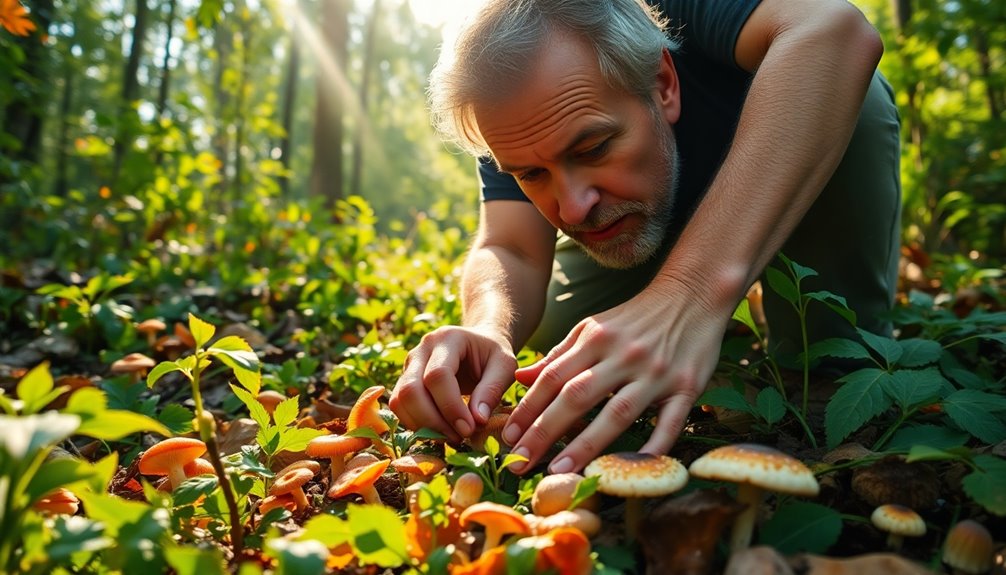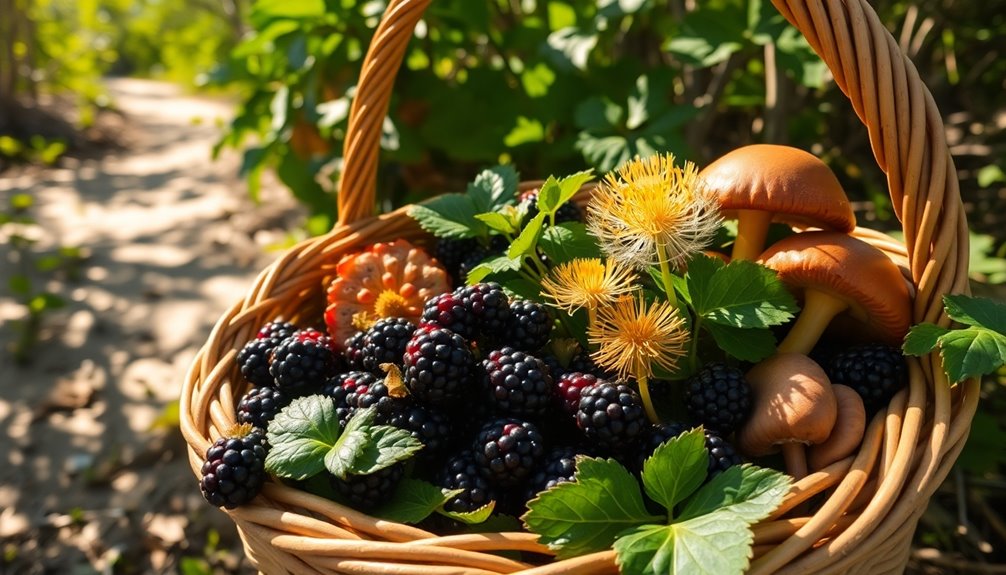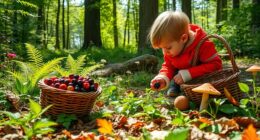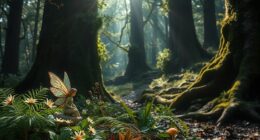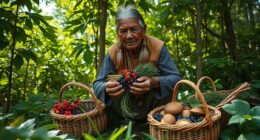Foraging means you're gathering wild, edible foods straight from nature, a practice that's integral to human history. It's not just about survival; it also connects you to local ecosystems and cultural traditions. You'll discover nutrient-dense plants and mushrooms that can enhance your meals and save you money. Plus, foraging promotes environmental awareness and responsible harvesting, showing respect for nature. It's crucial to learn identification skills to guarantee safety, and understanding local laws makes you a responsible forager. If you're curious about how to start your foraging journey and its deeper meanings, there's much more to explore.
Key Takeaways
- Foraging involves gathering wild foods, requiring skills in identification and sustainable harvesting from local ecosystems.
- Historically, foraging was crucial for survival and shaped food traditions, especially in indigenous and marginalized communities.
- Wild edibles are nutrient-dense and promote healthier eating while reducing grocery costs and environmental impact.
- Ethical foraging practices respect biodiversity, ensuring sustainable food sources and ecological balance for future generations.
- Seasonal awareness is vital for successful foraging, aligning harvesting with plant growth cycles for optimal yield and regeneration.
Definition of Foraging

Foraging is the practice of actively seeking out and gathering wild foods, like plants, mushrooms, fruits, and game. It's a skill that humans have relied on for millennia, rooted in our ability to identify and harvest what nature offers.
As you explore the world of foraging, you'll discover a variety of wild edibles, from dandelions and elderberries to blackberries and seasonal treasures like truffles and porcini mushrooms.
This practice not only provides you with delicious and nutritious wild food but also fosters a deeper connection to local ecosystems. By understanding the plants and animals in your area, you tap into Traditional Knowledge passed down through generations, enriching both your experience and understanding of nature.
In recent years, foraging has seen a resurgence, as many seek sustainable food sources and a way to reconnect with the environment.
However, it's crucial to approach foraging with awareness of its broader implications, considering issues of privilege and access to natural resources.
Ultimately, foraging represents more than just gathering food; it's about respecting the intricate relationships within our ecosystems and honoring the cultural significance tied to this age-old practice.
Historical Significance
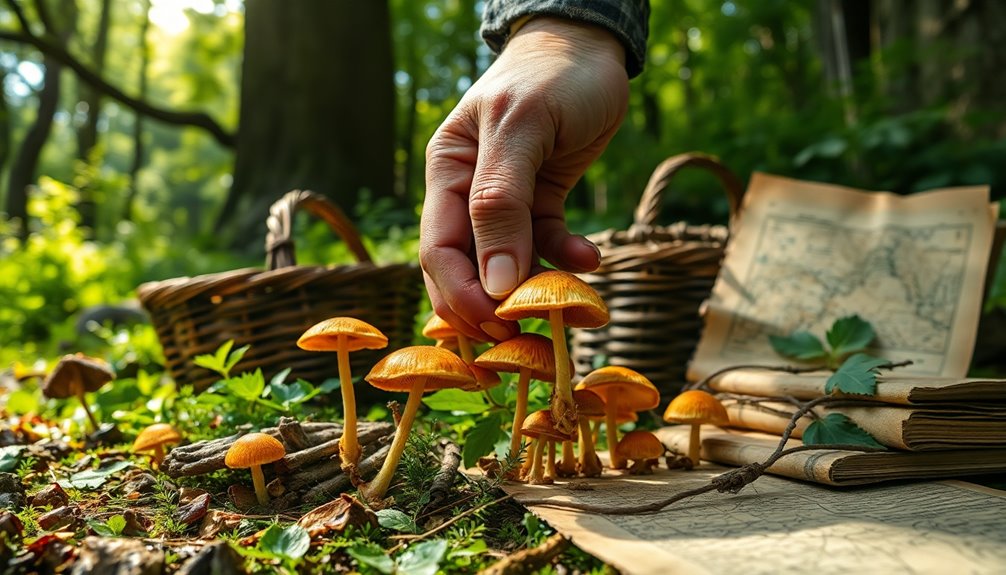
Throughout history, foraging has played an essential role in human survival, serving as the primary means of food production long before agriculture emerged. Foraging practices have been fundamental in various cultures, especially within indigenous communities, where they shaped food traditions and cultural identities. These practices allowed people to connect with their environment, relying on local resources to thrive.
In Black communities, foraging was a significant strategy during slavery and post-emancipation, providing wild food sources to supplement inadequate meals. Unfortunately, anti-foraging laws often targeted marginalized groups, reflecting systemic racism and classism by limiting their access to natural food sources. This historical context highlights the importance of foraging as more than just a means of survival; it's a reflection of resilience and adaptability.
Today, as you explore your local park or community, you may notice a resurgence of interest in sustainable foraging. This movement not only acknowledges the historical importance of these practices but also emphasizes the need to reconnect with nature and local ecosystems. Moreover, understanding the significance of traditional healing practices within Aboriginal cultures can deepen your appreciation for the natural resources available through foraging.
Understanding this history enriches your foraging experience, reminding you of its essential role in human survival and cultural heritage.
Culinary and Nutritional Benefits
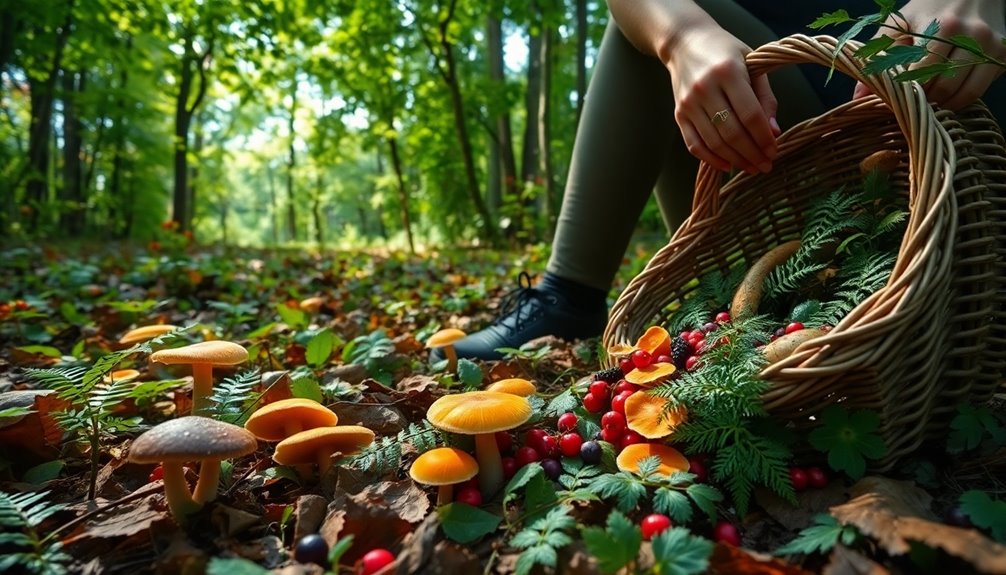
Exploring the world of wild edibles opens up a treasure trove of culinary and nutritional benefits that often go unnoticed in modern diets. Many foraged options, often dismissed as weeds, are surprisingly nutrient-dense, providing essential vitamins A and C, which promote overall health. Additionally, understanding mushroom foraging techniques can enhance your chances of finding high-quality wild edibles.
By incorporating these wild edibles into your meals, you can enjoy fresh, unprocessed foods that enhance your well-being.
Common wild foods like nettles, elderflowers, and wild garlic can be transformed into delicious dishes such as soups, jams, and pesto. This versatility allows you to experiment in the kitchen while savoring unique flavors that seasonal produce offers.
Foraging encourages you to consume food for free, reducing your grocery costs while supporting healthier eating habits.
Not only do these wild edibles enhance the nutritional profile of your meals, but they also offer a sustainable choice. Typically harvested without packaging or chemicals, foraged foods provide a lower environmental impact compared to conventional options.
In this way, embracing wild edibles can elevate your culinary experience, enrich your diet, and contribute positively to your surroundings. Additionally, understanding the principles of sustainable food sourcing can further enhance your foraging efforts and ensure responsible harvesting practices.
Environmental Stewardship
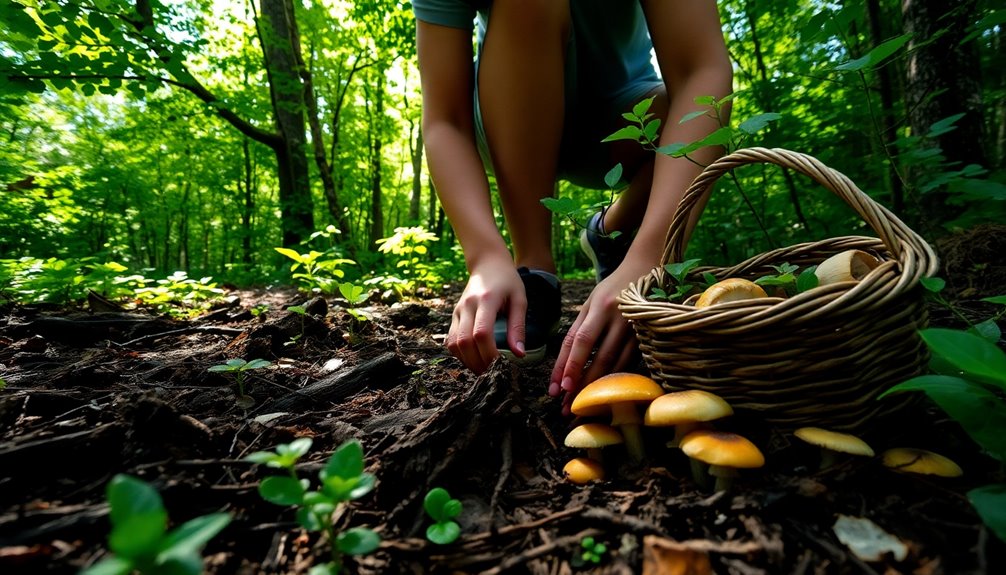
Engaging in foraging can greatly enhance your connection to the environment and promote environmental stewardship. By sourcing food from the wild, you actively participate in a sustainable food system that respects local ecosystems. Foraging is still a crucial practice for maintaining biodiversity, as it encourages the responsible harvesting of wild plants and fungi, particularly through techniques like sustainable harvesting. Additionally, foraging can introduce you to safe plants for pets, ensuring that your foraged finds are not harmful to your furry companions. In regions like Minnesota and Michigan, foraging can also help you discover over 300 species of wild edibles that contribute to local biodiversity.
| Aspect of Foraging | Benefits to Ecosystem | Your Role in Stewardship |
|---|---|---|
| Sustainable Harvesting | Supports local wildlife | Mindfully leave resources |
| Biodiversity Boost | Counters invasive species | Learn about local flora |
| Community Engagement | Raises conservation awareness | Participate in events |
| Ecological Balance | Enhances natural resources | Respect and protect nature |
When you forage, you cultivate a deeper understanding of ecological balance, enhancing your appreciation for natural resources. Mindful harvesting practices guarantee that you leave enough for wildlife and promote the regeneration of plant populations. As you engage with nature, you'll discover the importance of protecting native species and their habitats, making you an integral part of fostering environmental stewardship. Additionally, participating in foraging can help mitigate the negative impacts of wood-burning emissions, as it encourages a shift towards more sustainable practices.
Skills Needed for Foraging
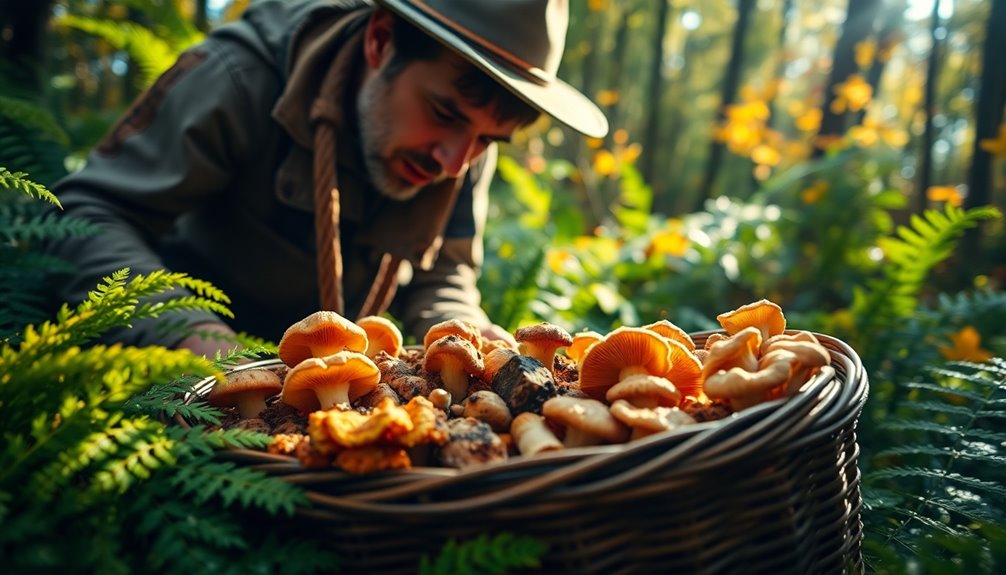
To forage successfully, you need strong plant identification techniques to distinguish edible species from toxic ones.
Being aware of the seasonal availability of plants will help you know when to harvest for maximum flavor and nutrition.
Plus, understanding local regulations guarantees you respect the land and stay within legal guidelines while foraging.
Plant Identification Techniques
While foraging can be a rewarding experience, mastering plant identification techniques is essential for guaranteeing safety and success. Start by familiarizing yourself with the distinctive characteristics of edible plants, like leaf shape, flower color, and growth habits. This knowledge helps you spot wild garlic and other valuable edibles while avoiding toxic look-alikes. Understanding the aura colors of plants can also provide insights into their vitality and potential edibility. Additionally, recognizing the benefits of educational toys can enhance the learning experience for young foragers by fostering curiosity and exploration. To further enrich your indoor gardening endeavors, consider incorporating unique and wicked planters that can creatively display your foraged herbs. Adding self-watering features to your planters can ensure that your herbs remain hydrated and healthy as you explore foraging.
Utilizing field guides or mobile applications focused on local flora can greatly enhance your identification skills. These tools provide essential information about the plants you encounter, including their edible parts.
Don't forget to pay attention to subtle changes in the environment and seasonal availability, as many edible species have specific harvesting times. Additionally, understanding the importance of payment processing can help you efficiently manage the sale of foraged goods if you decide to turn your hobby into a business.
Joining local foraging groups or workshops is another great way to sharpen your plant identification techniques. Learning from seasoned foragers provides practical experience that books and apps can't replicate.
Finally, when sampling a new wild food, remember the "try small amounts first" rule. This allows you to safely enjoy the bounty of nature without risking adverse reactions.
Mastering these skills will help you confidently explore the world of foraging while enjoying all it has to offer.
Seasonal Foraging Awareness
A solid understanding of seasonal foraging is important for anyone looking to gather wild foods effectively. You need to be aware of the seasonal availability of foraged items since wild foods peak at different times. For instance, spring is great for young nettles and wild garlic, while autumn brings blackberries and sweet chestnuts.
Equally important is your ability to differentiate between edible versus toxic plant species. It's essential to consult reliable foraging guides, especially as a novice, to avoid dangerous misidentifications. As you develop your skills, start with a few easy-to-identify plants before broadening your knowledge.
Mindfulness and respect for the environment are crucial when foraging. Practicing sustainable harvesting techniques guarantees that you protect local ecosystems and leave enough resources for wildlife.
Local Regulations and Guidelines
Understanding seasonal foraging is just the beginning; you also need to grasp local regulations and guidelines to forage responsibly. Foraging is often allowed in public spaces, but you must obtain permission when on private land. Familiarizing yourself with these local regulations is essential for a sustainable practice that respects both the environment and community.
Here's a quick overview of key regulations to take into account:
| Regulation Type | Description | Importance |
|---|---|---|
| Harvest Limits | Many areas limit the quantity of plants you can gather. | Guarantees sustainability |
| Protected Species | Some plants may be endangered or protected. | Maintains biodiversity |
| Public vs. Private Land | Always check if foraging is allowed on private property. | Prevents legal issues |
| Seasonal Guidelines | Certain plants are only available during specific times. | Increases foraging success |
| Wildlife Protection | Respect habitats and local wildlife needs. | Supports ecosystem health |
Community and Cultural Impact
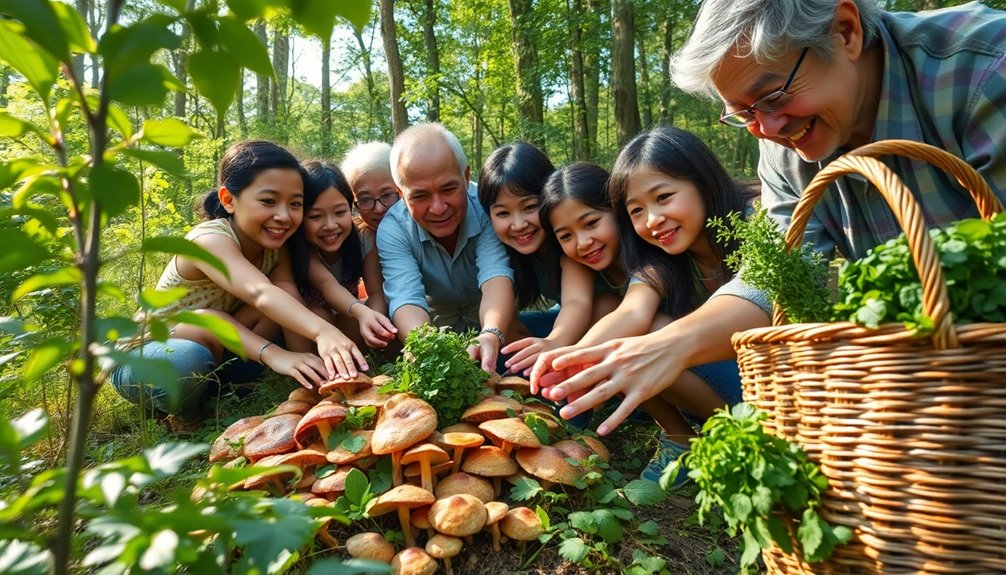
Foraging plays an essential role in shaping community ties and cultural identity. As you engage in foraging activities, you foster a sense of solidarity and connection with others. This practice not only brings people together but also allows you to share invaluable knowledge and experiences, strengthening community bonds.
For many, especially Black families during slavery and post-emancipation, foraging served as a crucial food source during times of scarcity.
Participating in local foraging events enhances cultural appreciation of native foods and highlights the significance of traditional practices. You'll find culinary creativity flourishing as you learn to incorporate foraged ingredients into your cooking, which encourages greater community engagement through workshops and group activities.
Moreover, the resurgence of foraging trends emphasizes the importance of amplifying the voices of Indigenous foragers. These individuals carry traditional ecological knowledge essential for sustainable practices.
Legal Considerations
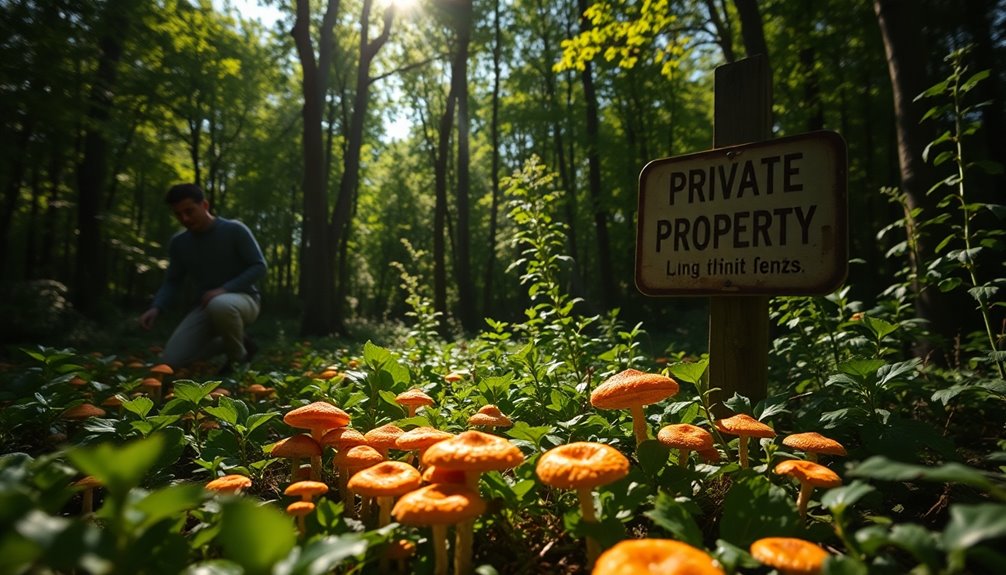
Engaging in foraging can be a rewarding experience, but it's important to navigate the legal landscape surrounding this activity. Understanding local regulations is essential, especially since foraging activities are often permitted in public spaces but may require permission on private land. Failing to adhere to these rules can lead to fines or other penalties.
Here's a quick overview of key legal considerations:
| Aspect | Public Land | Private Land |
|---|---|---|
| Permission Required | Generally not needed | Always needed |
| Local Regulations | Varies by location | Varies by property |
| Protected Species | Some restrictions apply | Strictly prohibited |
| Fines for Violations | Up to $250 (e.g., NYC) | Varies widely |
| Harvest Limits | Often enforced | Specified by owner |
Before you head out, take the time to research the specific laws in your area. Remember, some regions may have stricter rules than others, especially regarding protected species. Stay informed, and you'll enjoy a successful foraging experience while respecting the law.
Ethical Foraging Practices
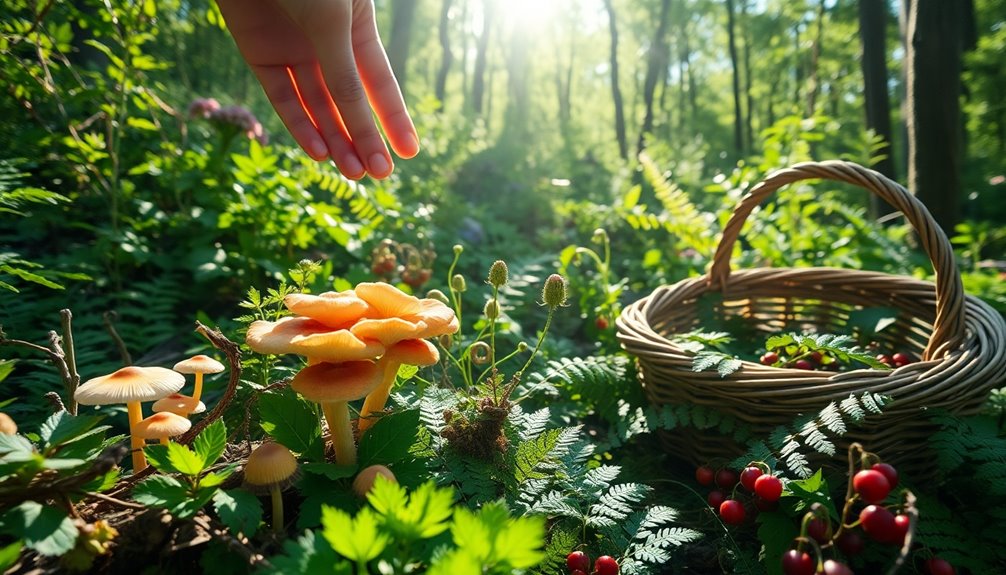
When you forage, it's essential to respect local regulations to guarantee you're not harming vulnerable ecosystems.
By using sustainable harvesting methods, you help maintain biodiversity and support the health of the environment.
Respecting Local Regulations
Respecting local regulations is a vital aspect of ethical foraging practices that can greatly affect both the environment and your experience. Before you head out to gather wild edibles, familiarize yourself with the specific laws governing foraging in your area.
While foraging is generally legal in public spaces, obtaining permission is imperative when exploring private land. Ignoring property rights not only violates local regulations but can also sour your foraging adventures.
Many parks and nature reserves permit foraging, but you must check for any posted regulations or necessary permits. These guidelines are often designed to protect native plant species and maintain ecosystem integrity.
By adhering to these rules, you contribute to sustainability and biodiversity. Additionally, being aware of seasonal availability and local habitats allows you to minimize your impact on ecosystems. This awareness guarantees that your foraging activities don't disrupt local flora and fauna.
Remember, ethical foraging isn't just about gathering food; it's about respecting the environment and making sure that these natural resources are available for future generations. Moreover, understanding the foraging range of local wildlife can help you make informed decisions that support ecological balance.
Sustainable Harvesting Methods
Sustainable harvesting methods are essential for maintaining the health of our ecosystems while foraging. By adopting ethical foraging practices, you guarantee that the plants and wildlife in your area thrive. One key principle is the "rule of thirds." This means you should only take one-third of a plant population, allowing enough for natural regrowth and supporting local biodiversity.
To navigate sustainable foraging effectively, consider the following table:
| Aspect | Importance | Action Required |
|---|---|---|
| Harvesting Amount | Supports ecological balance | Follow the rule of thirds |
| Seasonal Awareness | Optimizes plant health | Harvest at the right times |
| Local Regulations | Protects natural habitats | Familiarize yourself with laws |
| Environmental Impact | Minimizes harm to ecosystems | Practice mindfulness while foraging |
| Leave No Trace | Preserves natural areas | Clean up and respect the land |
Frequently Asked Questions
What Is Foraging in Simple Terms?
Imagine strolling through a vibrant forest, where nature's buffet awaits you. Foraging is simply the practice of searching for and gathering wild food like plants, fruits, and mushrooms.
You identify what's edible and collect it for your meals. It's a way to connect with nature, embrace sustainability, and enjoy fresh, chemical-free ingredients.
What Does Foraging Refer To?
Foraging refers to the practice of searching for and gathering wild foods in nature.
You'll find edible plants, fruits, mushrooms, and herbs that can be consumed or used for medicinal purposes. Historically, it's been an essential way for humans to sustain themselves before agriculture took over.
Nowadays, you're likely to see a renewed interest in foraging as people seek sustainable food sources and a deeper connection to the natural world around them.
What Is the Golden Rule of Foraging?
Imagine yourself wandering through an ancient forest, basket in hand, ready to gather nature's bounty.
The golden rule of foraging is simple: "leave no trace." You should only take what you need, ensuring you don't harm the environment or over-harvest species.
Always identify plants correctly, respect local regulations, and practice mindfulness.
What Is Foraging in Humans?
Foraging in humans is the practice of actively searching for and gathering wild food resources, like plants, fruits, and mushrooms.
It's a skill that lets you connect with nature while discovering local edible treasures. You learn to identify what's safe to eat and when to find it, fostering a deeper appreciation for your environment.
Conclusion
To wrap it up, foraging isn't just about gathering food; it's a rich blend of history, culture, and sustainability. Did you know that nearly 25% of the world's plant species are edible? By embracing foraging, you not only discover delicious, nutritious options but also connect with nature and your community. So, grab a basket, explore your surroundings, and engage with the world of foraging—there's a wealth of knowledge waiting for you just outside your door!

